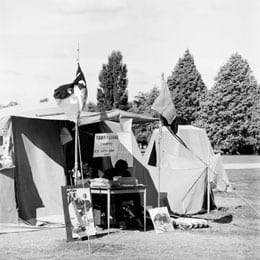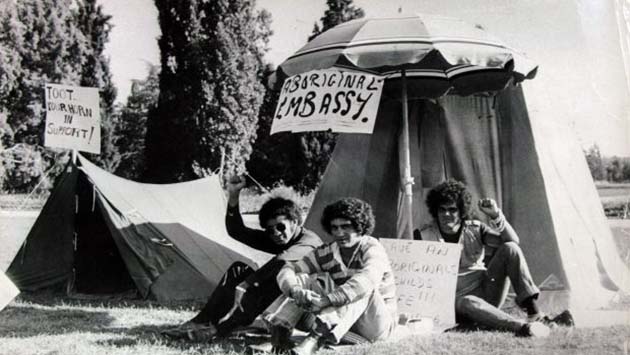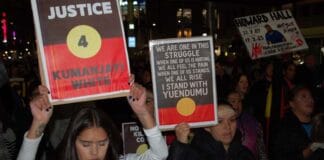The establishment of the Aboriginal Tent Embassy in 1972 was one of the high points of the Aboriginal rights movement. Forty years on, Solidarity looks at what it achieved and its relevance today
The Tent Embassy 40th anniversary protest this year has re-opened the debate about the relevance of Aboriginal protest.
The right-wing media has attacked it, using comments from conservative Aboriginal figures such as Warren Mundine, who called the protest “a disgrace” and declared that the Tent Embassy no longer represented the majority of Aboriginal people.
But 40 years on, the Tent Embassy’s demands are every bit as relevant today as they were in 1972. The Northern Territory Intervention laws expire in June this year, and although the punitive policies have failed by every social measure, Minister Jenny Macklin is determined to entrench the government’s racist policies for another ten years.

The Tent Embassy showed that a protest movement that set out to confront the government could put Aboriginal rights on the agenda and win real changes. Its story contains important lessons for the fight today.
‘Land now, not lease tomorrow’
In 1971 a Supreme Court challenge by the Yirrkala people against the Nabalco mining company ended with Justice Blackburn ruling that Aboriginal people had a spiritual connection to their land, but no property rights to it under law.
Then, on the eve of Invasion Day in 1972 Coalition Prime Minister Billy McMahon announced that the government would not recognise land rights through legislation.
The next day four Aboriginal activists, Michael Anderson, Billy Craigie, Bertie Williams and Tony Coorey, travelled from Sydney to Canberra in a car driven by Communist Party photographer Noel Hazard to establish an Aboriginal Tent Embassy. They planted a beach umbrella on the lawns of parliament house and held placards that read “Land rights now or else”, “Legally this land is our land. We shall take it if need be” and “Land now not lease tomorrow” on the morning of Invasion Day 1972.
Originally this was intended as a protest stunt to highlight how Aboriginal people continued to live as aliens in their own land. But when they arrived they discovered that a legal loophole allowed camping on the Parliamentary lawns. When they realised they could not be removed they began erecting tents. The Tent Embassy remained for several months and became a central rallying point for the Aboriginal rights movement.
Queensland University students raised the money to send a busload of radical black activists down to Canberra. Others came from across the country came to join them.
The Embassy was a constant embarrassment to the McMahon government. Hoping it would disappear they claimed it represented only a “handful of militants.” But the Embassy represented the demands of more than a handful.
After the landslide 1967 referendum, which extended citizenship to Aboriginal people, campaigners had hoped conditions in Aboriginal communities would improve.
But very little changed. The government continued to revoke Aboriginal reserve land, forcing families into the cities. Aboriginal people lived in squalid housing, facing the constant threat of eviction, lived in segregated communities and encountered daily police violence.
The failure of the Yirrkala court action and McMahon’s subsequent rejection of land rights showed many people that neither parliament nor the existing legal system was going to guarantee an end to discrimination against Aboriginal people.
Radicalism
The Tent Embassy drew inspiration from the growing student and working class radicalism of the 1960s and 1970s, including widespread strike action, the movement against the Vietnam War, as well as the anti-colonial struggles across the world and the civil rights movement in the US.
Since the 1960s demands for land rights had grown. In 1966 over 200 Aboriginal workers on Lord Vestey’s cattle station in the NT began a three-year strike against virtual slavery conditions.
White unionists from the Actors Equity Union and the Building Workers Industrial Union toured Gurindji people in workplaces across the country to speak about their struggle. The NSW Builders Labourers’ Federation (BLF) raised over $600 to support their strike action.
With the support of white workers the Gurindji people not only won equal wages, but eventually the ownership of their land in 1975. The Gurindji strike put land rights on the political agenda.
In 1971 white students, Aboriginal activists and the union movement mobilised against the apartheid South African Springbok rugby team when the government tried to tour them around Australia. Airline workers made it impossible for the rugby players to fly. Postal workers refused to handle South African mail. In Melbourne 4000 wharfies struck for a week against the rugby tour. Due to the success of the campaign, no South African team toured Australia until apartheid ended in 1994.
A leading activist from the time, Meredith Burgmann, recalls: “young Aboriginal activists of the time were very prominent in the demonstrations against the Springboks, so people like me had actually met and started working with Aboriginal activists.”
The union involvement against apartheid showed how workers could be won to taking up anti-racist demands. These struggles showed how Aboriginal people could unite with white workers to fight back and win against racism.
Land rights
The Tent Embassy gave a boost to the campaign for land rights. On July 14 in the same year the Tent Embassy was established, 6000 people marched in Sydney as part of the “Black Moratorium”, demanding land rights for Aboriginal people.
The idea of Moratorium marches came from the successful Moratoriums against the Vietnam War. Five hundred Aboriginal people led a march including 2000 Sydney University students, as well as Builders Labourers, wharfies and teachers. In Sydney a BLF worker dropped a banner advertising the rally from his crane on a construction site. In Wollongong the South Coast Trades and Labour Council joined the march. Another 1000 marched in Melbourne.
The same month, the McMahon government drew up a new law making camping on parliamentary lawns illegal. Without warning, on July 20, 100 police descended on the Embassy and violently cracked down, removing the tents and arresting eight people.
Three days later, on July 23, 200 demonstrators tried to re-establish the embassy and were met with a vicious response from police. Bob Pringle, the NSW BLF Secretary, was there on the day and recalled: “362 Robots of the law marched out in military fashion and turned about in unison and then mechanically smashed us. Many people were seriously injured”.
But Aboriginal activist Bobbi Sykes, a leading member of the Tent Embassy’s “diplomatic staff” said: “The actions of the police are creating militants for us. People would come from all over Australia to support us if they had the money to get here.”
On July 30 the movement responded with a 2000-strong march that included white students, builders labourers and workers from across Canberra. It was the largest land rights demonstration in Canberra’s history.
In the spirit of gross over-policing at the Embassy, the government cancelled all police leave in the ACT, kept the riot squad on hand and had the Royal Military College on alert for good measure.
In the end police allowed the protesters to re-establish the embassy again for two hours. After that the police were allowed to take down the tents without a further confrontation.
What did it achieve?
The 1970s were a period of some of the most important gains in the history of Aboriginal politics.
The Tent Embassy’s demands included: an Aboriginal controlled state in the NT; legal title and mining rights to all reserve lands, as well as the land around capital cities; the preservation of sacred sites and compensation for lands lost including a $6 billion down payment. Underlying them was a desire for an end to the policy of assimilation into white society and and a demand for self-determination and Aboriginal control over their land, communities and lives.
The Whitlam Labor government rode to power at the end of 1972 on the back of social movements, including the Aboriginal rights movement. Whitlam dropped the charges against activists over the Tent Embassy protests and abolished assimilation as official policy, creating the first Department of Aboriginal Affairs. His government also drew up the NT Land Rights Act that was eventually passed under the Liberal Fraser government, which finally gave the Gurindji and many other Aboriginal communities in the NT back their land.
These steps were significant gains for Aboriginal people showed the power of political protest to win gains.
But the government never fully delivered self-determination or the compensation for dispossession that were demanded in the 1970s. In the decades since the Tent Embassy, subsequent governments have left Aboriginal communities poverty-stricken, under-resourced and disadvantaged.
Today there is an attempt to wind back the gains of the past through an ongoing assault on the “rights agenda” and the goal of self-determination for Aboriginal people.
The NT Intervention is in many ways a return to the assimilationist policies in place before the 1970s. Communities operate under government control and there is pressure on Aboriginal people to leave their traditional land where the government deems communities “unviable”.
Native title has not delivered anything for the majority of Aboriginal people.
The Tent Embassy represented the emergence of a mass movement for Aboriginal rights and a layer of radical black activists who rejected the idea that the courts or politely lobbying parliament could win change.
The unity between Aboriginal activists and the organised working class was a central feature of the Tent Embassy’s successes.
A return to these politics today could begin to reverse the backlash against Aboriginal rights.






